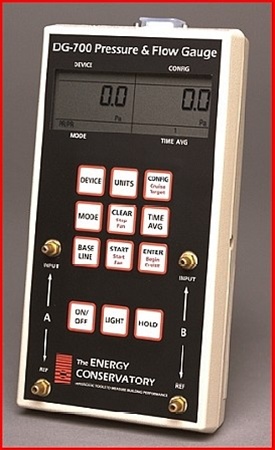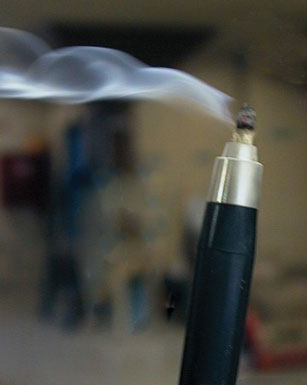CAZ (Combustion Appliance Zone) Test
Combustion Safety &
Worst Case Depressurization Test
Make sure that if all the exhaust fans in a home are running, you don't end up with dangerous exhaust inside the living space
The Problem
Vented combustion appliances—gas and fuel oil water heaters, furnaces, boilers, even fireplaces—need to exhaust all of their combustion by-products, all the time, outside the home. An especially dangerous combustion exhaust component is carbon monoxide because it is odorless, colorless, tasteless and quite toxic. If you have no combustion appliances or they are sealed-combustion, no worries. But if any of these appliances is atmospherically-vented or has induced draft or even if they are power-vented, we need to test to see if conditions in the home can create backdrafting (backdrafting is combustion exhaust rolling out of the intended exhaust pathway and into the home).
The Test
There is actually a series of combustion safety tests, but we are going to focus on the simplest and most often the first test, the Worst Case Depressurization Test, also known as the worst-case CAZ—combustion appliance zone—test. So what is the worst case? Essentially, you turn on every device in the home that can create negative pressure in the room or space in which the combustion appliance is located and compare that pressure to the outside. Here is a list of these devices:
• Bath exhaust fans – typically pull somewhere between 25 and 100 cubic feet per minute (cfm) out of the house)
• Kitchen hood (if it really vents to the outside) – usually around 100 – 150 cfm but downdrafting or commercial types can exhaust more than 1500 cfm!
• Clothes dryer – usually around 150 cfm
• Laundry room exhaust fan – about the same as a bath fan
• Attic exhaust fan
• HVAC air handler
There are three things to note about this list:
-
Attic exhaust fans: Aren’t these just to cool off the attic and the attic is outside of the conditioned space? They are, but if the ceiling plane of the top floor is not air tight, attic exhaust fans can end up depressurizing a home’s interior.
-
Air handlers: They just move air around the INSIDE of the home, right? Well, that is what they are SUPPOSED to do, but if there are ducts that run through unconditioned space that leak—or if there is unbalanced delivery/leakage between the supply and return side of the system that expresses itself in the space with a combustion appliance—the air handler can de-pressurize the CAZ. So, we need to test worst case with and without the air handler on, if the home has a forced-air HVAC system.
-
Whole-house attic ventilation fans: These are mighty large exhaust fans; shouldn’t they be on the list? While these fans can certainly depressurize a home big time, they are not included in the CAZ test. It is assumed that since these fans are for cooling by air movement, enough windows are open during operation of the fan that depressurization and subsequent backdrafting are not an issue.

